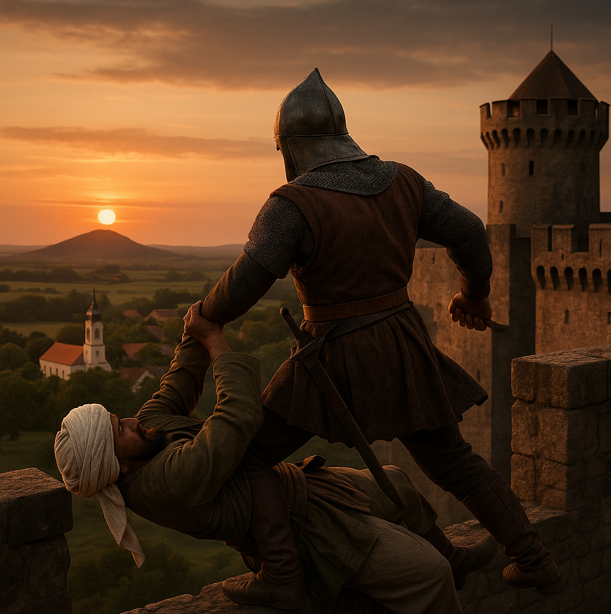
Hike around Sárvár, in the footsteps of heroes!
If you want to explore the wandering landscape of the Kemenesalja and Kemeneshat in Western Transdanubia, the Nádasdy Castle in Sárvár and the fictional history of the Nádasdy family are the best places to visit. But if you’re looking for something really special, you’ll find yourself a pleasant hike away from our guesthouses, at least as far as the characters are concerned, in the Hunyadi series.
One of the key characters in the Triumph of Nándorfehérvár is the self-sacrificing Titus Dugovics, a native of Nagysimonyi, a tiny village on the road from Sárvár towards Pápa. He was the one who dragged the Turkish soldier who was about to raise the crescent flag on the castle tower into the abyss. Sitke – where our apartment houses are nestled at the foot of Hercseg Hill – is halfway between Sárvár and Nagysimonyi. The road in front of our guesthouses is a pleasant hike or easy bike ride from Titus Dugovics’ home village, and you don’t even have to avoid cars.
Few people know it, but the real legend is not related to Titusz, and his story is much more Hungarian than you might think. The heroic figure of Titus Dugovics appears in several independent historical sources after the victory of Nándorfehérvár, but then disappears for four hundred years. Only in the early 1800s does his name reappear as a native of Nagysimonyi in the Sárvár estate.
In fact, he is not the only legend in this strange land. From our guesthouses you can make countless more exploratory tours to discover the natural, historical, cultural, religious and esoteric wonders of the Sárvár region. But if you have left the tranquillity of our apartment houses behind you and have followed in the footsteps of the Dugovics family, you don’t have to miss out on the natural beauty. Along the dusty little road, you’ll pass through beautiful yellowing rapeseed fields around May, while the mystical mass of Mount Ság fills the skyline and tiny hills tell of a time when fire ruled the land. From Sárvár, the first thing that lights up in the distance on the way to Nagysimonyi is the snow-white building with its double windows, which looks more like a fortress than a church. The Lutheran church was already standing at the time when Titus Dugovic’s name reappeared in the historical chronicles.
A late relative, a certain Imre Dugovics, based on contemporary charters of Mátyás, Gábor Döbrentei published an article about the hero in 1824 in the Scientific Collection. If Titus Dugovics was a model of Hungarian heroism and self-sacrifice, Imre Dugovics was a model of Hungarian ingenuity. In the 1820s, he had to prove his nobility in a difficult situation, and his heroic ancestor was particularly useful in this respect. The story also inspired one of the most prominent painters of Hungarian Romanticism, Sándor Wágner, who painted his masterpiece The Self-sacrifice of Titus Dugovics in 1859.
The legend of Titus continued to commemorate the heroic sacrifice for nearly 150 years, until the 1990s, when it was discovered that the documents had been forged by the elusive nobleman Imre Dugovics of Iron County, and their authenticity was at least highly questionable. However, the figure of the self-sacrificing hero is so deeply embedded in the collective memory of the population around Sárvár and of the Hungarian people that it cannot be obscured by the battles and the findings of historians.
While walking or cycling from Nagysimonyi to our guesthouses, it is worth wondering why, if the person of Titus was a fiction of Imre Dugovics, the famous historian of Mátyás, Master Bonfini, mentioned the figure of this valiant in his contemporary texts… And the series of mysteries and legends in the region around Sárvár is far from being over.